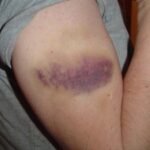Bone bruises are painful injuries to the bone in which your bone hits a hard surface and results in tiny fractures in the outer layer of the bone, called the cortex. Not identifiable by an X-ray as it is not a true break, a bone bruise typically does not encompass any swelling or bumps that a typical bruise would cause, but boy, do bone bruises take a long time to heal!
A bone bruise typically occurs when your bone hits something that is hard enough to “crack” the outer layer of your bone. Now your body is responsible for repairing the tiny fractures, which can take a long time. The bone consists of several layers of fibers that appear to criss-cross with one another to form solid bone. When a bone bruise occurs, not only does your body have to remove the damaged fiber, but the leaking calcium from the area of the bone that is damaged as well, and start all over. This is why a bone bruise can take so long to heal. It can take days, weeks, and often months for your body to fully repair a bone bruise and rebuild all that was damaged.
Bone bruises hurt because any break of bone hurts. The only problem is, a bone bruise isn’t a true break. It’s almost a borderline fracture, but that’s about it. Indiscernible by an X-ray and typically not resulting in a huge outer bruise, a bone bruise is noticeable due to the intense pain it can cause. Extremely tender to the touch, a bone bruise can feel excruciating up until it finally completely heals, and since it’s not a true fracture, the bone is still safe to utilize, although you won’t want to cause more damage.
The best way to heal a bone bruise is to allow your body to do its job the best it can. This means avoiding strenuous activities that can “re-bruise” your bone. Even slightly hitting that same bone again can undo all the repair that your body has started and make the healing process start all over again. It takes time for the new bone and calcium to become super strong, so you have to be tender with a bone bruise to allow the bone to repair most successfully.
Rest is a big one, as is ice, although both are more for the benefit of relieving pain than rebuilding the bone. However, a relaxed body is a healing one, so try to keep off the bone bruise as much as possible. Since knee bone bruises are the most common, this can be difficult, but a brace or bandage for support and limiting mobility for a few weeks certainly helps.
There is no real “cure” for a bone bruise. You can’t cast it, and you can’t make time go any faster than it already is. You can, however, keep the bone bruise protected by babying it for a few weeks and keeping the area as undisturbed as possible so your body can heal and remain healing.
If you notice swelling, severe pain after more than a few weeks, or worsening pain, fever, or odd joint movement in your bone bruise, see your doctor to rule out any other possible injuries. A bone bruise should not swell. It should hurt like hell, but it should not affect health or mobility other than the mother-lovin’ pain that makes you not want to move the bone bruise area so much.
http://www.fightingarts.com/reading/article.php?id=122



